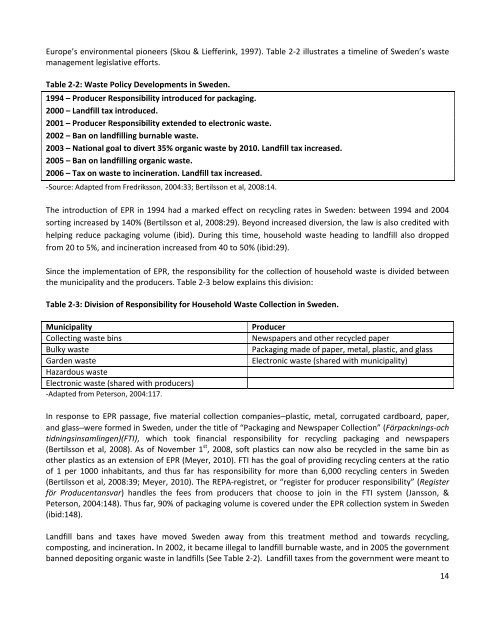Waste prevention and Pay as You Throw, a collective case ... - lumes
Waste prevention and Pay as You Throw, a collective case ... - lumes
Waste prevention and Pay as You Throw, a collective case ... - lumes
You also want an ePaper? Increase the reach of your titles
YUMPU automatically turns print PDFs into web optimized ePapers that Google loves.
Europe’s environmental pioneers (Skou & Liefferink, 1997). Table 2‐2 illustrates a timeline of Sweden’s w<strong>as</strong>te<br />
management legislative efforts.<br />
Table 2‐2: <strong>W<strong>as</strong>te</strong> Policy Developments in Sweden.<br />
1994 – Producer Responsibility introduced for packaging.<br />
2000 – L<strong>and</strong>fill tax introduced.<br />
2001 – Producer Responsibility extended to electronic w<strong>as</strong>te.<br />
2002 – Ban on l<strong>and</strong>filling burnable w<strong>as</strong>te.<br />
2003 – National goal to divert 35% organic w<strong>as</strong>te by 2010. L<strong>and</strong>fill tax incre<strong>as</strong>ed.<br />
2005 – Ban on l<strong>and</strong>filling organic w<strong>as</strong>te.<br />
2006 – Tax on w<strong>as</strong>te to incineration. L<strong>and</strong>fill tax incre<strong>as</strong>ed.<br />
‐Source: Adapted from Fredriksson, 2004:33; Bertilsson et al, 2008:14.<br />
The introduction of EPR in 1994 had a marked effect on recycling rates in Sweden: between 1994 <strong>and</strong> 2004<br />
sorting incre<strong>as</strong>ed by 140% (Bertilsson et al, 2008:29). Beyond incre<strong>as</strong>ed diversion, the law is also credited with<br />
helping reduce packaging volume (ibid). During this time, household w<strong>as</strong>te heading to l<strong>and</strong>fill also dropped<br />
from 20 to 5%, <strong>and</strong> incineration incre<strong>as</strong>ed from 40 to 50% (ibid:29).<br />
Since the implementation of EPR, the responsibility for the collection of household w<strong>as</strong>te is divided between<br />
the municipality <strong>and</strong> the producers. Table 2‐3 below explains this division:<br />
Table 2‐3: Division of Responsibility for Household <strong>W<strong>as</strong>te</strong> Collection in Sweden.<br />
Municipality<br />
Collecting w<strong>as</strong>te bins<br />
Bulky w<strong>as</strong>te<br />
Garden w<strong>as</strong>te<br />
Hazardous w<strong>as</strong>te<br />
Electronic w<strong>as</strong>te (shared with producers)<br />
‐Adapted from Peterson, 2004:117.<br />
Producer<br />
Newspapers <strong>and</strong> other recycled paper<br />
Packaging made of paper, metal, pl<strong>as</strong>tic, <strong>and</strong> gl<strong>as</strong>s<br />
Electronic w<strong>as</strong>te (shared with municipality)<br />
In response to EPR p<strong>as</strong>sage, five material collection companies–pl<strong>as</strong>tic, metal, corrugated cardboard, paper,<br />
<strong>and</strong> gl<strong>as</strong>s–were formed in Sweden, under the title of “Packaging <strong>and</strong> Newspaper Collection” (Förpacknings‐och<br />
tidningsinsamlingen)(FTI), which took financial responsibility for recycling packaging <strong>and</strong> newspapers<br />
(Bertilsson et al, 2008). As of November 1 st , 2008, soft pl<strong>as</strong>tics can now also be recycled in the same bin <strong>as</strong><br />
other pl<strong>as</strong>tics <strong>as</strong> an extension of EPR (Meyer, 2010). FTI h<strong>as</strong> the goal of providing recycling centers at the ratio<br />
of 1 per 1000 inhabitants, <strong>and</strong> thus far h<strong>as</strong> responsibility for more than 6,000 recycling centers in Sweden<br />
(Bertilsson et al, 2008:39; Meyer, 2010). The REPA‐registret, or “register for producer responsibility” (Register<br />
för Producentansvar) h<strong>and</strong>les the fees from producers that choose to join in the FTI system (Jansson, &<br />
Peterson, 2004:148). Thus far, 90% of packaging volume is covered under the EPR collection system in Sweden<br />
(ibid:148).<br />
L<strong>and</strong>fill bans <strong>and</strong> taxes have moved Sweden away from this treatment method <strong>and</strong> towards recycling,<br />
composting, <strong>and</strong> incineration. In 2002, it became illegal to l<strong>and</strong>fill burnable w<strong>as</strong>te, <strong>and</strong> in 2005 the government<br />
banned depositing organic w<strong>as</strong>te in l<strong>and</strong>fills (See Table 2‐2). L<strong>and</strong>fill taxes from the government were meant to<br />
14
















